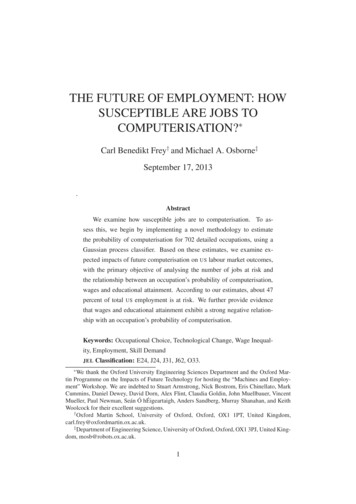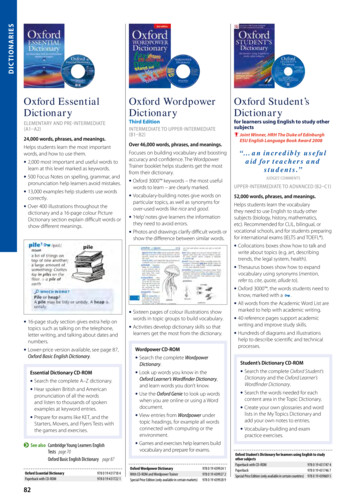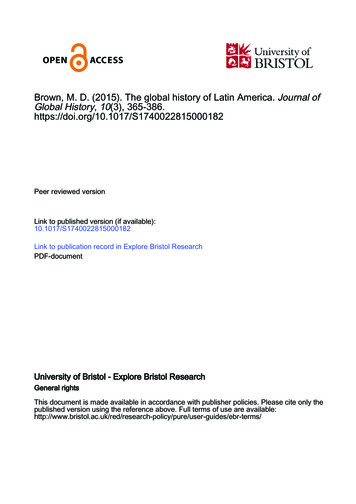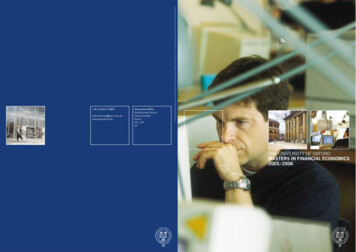
Transcription
THE FUTURE OF EMPLOYMENT: HOWSUSCEPTIBLE ARE JOBS TOCOMPUTERISATION? Carl Benedikt Frey† and Michael A. Osborne‡September 17, 2013.AbstractWe examine how susceptible jobs are to computerisation. To assess this, we begin by implementing a novel methodology to estimatethe probability of computerisation for 702 detailed occupations, using aGaussian process classifier. Based on these estimates, we examine expected impacts of future computerisation on US labour market outcomes,with the primary objective of analysing the number of jobs at risk andthe relationship between an occupation’s probability of computerisation,wages and educational attainment. According to our estimates, about 47percent of totalUSemployment is at risk. We further provide evidencethat wages and educational attainment exhibit a strong negative relationship with an occupation’s probability of computerisation.Keywords: Occupational Choice, Technological Change, Wage Inequality, Employment, Skill DemandJELClassification: E24, J24, J31, J62, O33.We thank the Oxford University Engineering Sciences Department and the Oxford Martin Programme on the Impacts of Future Technology for hosting the “Machines and Employment” Workshop. We are indebted to Stuart Armstrong, Nick Bostrom, Eris Chinellato, MarkCummins, Daniel Dewey, David Dorn, Alex Flint, Claudia Goldin, John Muellbauer, VincentMueller, Paul Newman, Seán Ó hÉigeartaigh, Anders Sandberg, Murray Shanahan, and KeithWoolcock for their excellent suggestions.†Oxford Martin School, University of Oxford, Oxford, OX1 1PT, United ent of Engineering Science, University of Oxford, Oxford, OX1 3PJ, United Kingdom, mosb@robots.ox.ac.uk. 1
I.I NTRODUCTIONIn this paper, we address the question: how susceptible are jobs to computerisation? Doing so, we build on the existing literature in two ways. First, drawingupon recent advances in Machine Learning (ML) and Mobile Robotics (MR),we develop a novel methodology to categorise occupations according to theirsusceptibility to computerisation.1 Second, we implement this methodology toestimate the probability of computerisation for 702 detailed occupations, andexamine expected impacts of future computerisation on US labour market outcomes.Our paper is motivated by John Maynard Keynes’s frequently cited prediction of widespread technological unemployment “due to our discovery ofmeans of economising the use of labour outrunning the pace at which wecan find new uses for labour” (Keynes, 1933, p. 3). Indeed, over the pastdecades, computers have substituted for a number of jobs, including the functions of bookkeepers, cashiers and telephone operators (Bresnahan, 1999; MGI,2013). More recently, the poor performance of labour markets across advancedeconomies has intensified the debate about technological unemployment amongeconomists. While there is ongoing disagreement about the driving forcesbehind the persistently high unemployment rates, a number of scholars havepointed at computer-controlled equipment as a possible explanation for recentjobless growth (see, for example, Brynjolfsson and McAfee, 2011).2The impact of computerisation on labour market outcomes is well-establishedin the literature, documenting the decline of employment in routine intensiveoccupations – i.e. occupations mainly consisting of tasks following well-definedprocedures that can easily be performed by sophisticated algorithms. For example, studies by Charles, et al. (2013) and Jaimovich and Siu (2012) emphasisethat the ongoing decline in manufacturing employment and the disappearanceof other routine jobs is causing the current low rates of employment.3 In ad1We refer to computerisation as job automation by means of computer-controlled equipment.2This view finds support in a recent survey by the McKinsey Global Institute (MGI), showingthat 44 percent of firms which reduced their headcount since the financial crisis of 2008 haddone so by means of automation (MGI, 2011).3Because the core job tasks of manufacturing occupations follow well-defined repetitiveprocedures, they can easily be codified in computer software and thus performed by computers(Acemoglu and Autor, 2011).2
dition to the computerisation of routine manufacturing tasks, Autor and Dorn(2013) document a structural shift in the labour market, with workers reallocating their labour supply from middle-income manufacturing to low-incomeservice occupations. Arguably, this is because the manual tasks of service occupations are less susceptible to computerisation, as they require a higher degreeof flexibility and physical adaptability (Autor, et al., 2003; Goos and Manning,2007; Autor and Dorn, 2013).At the same time, with falling prices of computing, problem-solving skillsare becoming relatively productive, explaining the substantial employment growthin occupations involving cognitive tasks where skilled labour has a comparativeadvantage, as well as the persistent increase in returns to education (Katz andMurphy, 1992; Acemoglu, 2002; Autor and Dorn, 2013). The title “Lousy andLovely Jobs”, of recent work by Goos and Manning (2007), thus captures theessence of the current trend towards labour market polarization, with growingemployment in high-income cognitive jobs and low-income manual occupations, accompanied by a hollowing-out of middle-income routine jobs.According to Brynjolfsson and McAfee (2011), the pace of technological innovation is still increasing, with more sophisticated software technologies disrupting labour markets by making workers redundant. What is strikingabout the examples in their book is that computerisation is no longer confinedto routine manufacturing tasks. The autonomous driverless cars, developed byGoogle, provide one example of how manual tasks in transport and logisticsmay soon be automated. In the section “In Domain After Domain, Computers Race Ahead”, they emphasise how fast moving these developments havebeen. Less than ten years ago, in the chapter “Why People Still Matter”, Levyand Murnane (2004) pointed at the difficulties of replicating human perception,asserting that driving in traffic is insusceptible to automation: “But executing a left turn against oncoming traffic involves so many factors that it is hardto imagine discovering the set of rules that can replicate a driver’s behaviour[. . . ]”. Six years later, in October 2010, Google announced that it had modified several Toyota Priuses to be fully autonomous (Brynjolfsson and McAfee,2011).To our knowledge, no study has yet quantified what recent technologicalprogress is likely to mean for the future of employment. The present studyintends to bridge this gap in the literature. Although there are indeed existing3
useful frameworks for examining the impact of computers on the occupationalemployment composition, they seem inadequate in explaining the impact oftechnological trends going beyond the computerisation of routine tasks. Seminal work by Autor, et al. (2003), for example, distinguishes between cognitiveand manual tasks on the one hand, and routine and non-routine tasks on theother. While the computer substitution for both cognitive and manual routinetasks is evident, non-routine tasks involve everything from legal writing, truckdriving and medical diagnoses, to persuading and selling. In the present study,we will argue that legal writing and truck driving will soon be automated, whilepersuading, for instance, will not. Drawing upon recent developments in Engineering Sciences, and in particular advances in the fields of ML, includingData Mining, Machine Vision, Computational Statistics and other sub-fields ofArtificial Intelligence, as well as MR, we derive additional dimensions requiredto understand the susceptibility of jobs to computerisation. Needless to say,a number of factors are driving decisions to automate and we cannot capturethese in full. Rather we aim, from a technological capabilities point of view,to determine which problems engineers need to solve for specific occupationsto be automated. By highlighting these problems, their difficulty and to whichoccupations they relate, we categorise jobs according to their susceptibility tocomputerisation. The characteristics of these problems were matched to different occupational characteristics, using O NET data, allowing us to examinethe future direction of technological change in terms of its impact on the occupational composition of the labour market, but also the number of jobs at riskshould these technologies materialise.The present study relates to two literatures. First, our analysis builds on thelabour economics literature on the task content of employment (Autor, et al.,2003; Goos and Manning, 2007; Autor and Dorn, 2013). Based on definedpremises about what computers do, this literature examines the historical impact of computerisation on the occupational composition of the labour market. However, the scope of what computers do has recently expanded, and willinevitably continue to do so (Brynjolfsson and McAfee, 2011; MGI, 2013).Drawing upon recent progress in ML, we expand the premises about the taskscomputers are and will be suited to accomplish. Doing so, we build on the taskcontent literature in a forward-looking manner. Furthermore, whereas this literature has largely focused on task measures from the Dictionary of Occupational4
Titles (DOT), last revised in 1991, we rely on the 2010 version of the DOT successor O NET – an online service developed for the US Department of Labor.4Accordingly, O NET has the advantage of providing more recent informationon occupational work activities.Second, our study relates to the literature examining the offshoring of information-based tasks to foreign worksites (Jensen and Kletzer, 2005; Blinder,2009; Jensen and Kletzer, 2010; Oldenski, 2012; Blinder and Krueger, 2013).This literature consists of different methodologies to rank and categorise occupations according to their susceptibility to offshoring. For example, usingO NET data on the nature of work done in different occupations, Blinder (2009)estimates that 22 to 29 percent of US jobs are or will be offshorable in the nextdecade or two. These estimates are based on two defining characteristics of jobsthat cannot be offshored: (a) the job must be performed at a specific work loca-tion; and (b) the job requires face-to-face personal communication. Naturally,the characteristics of occupations that can be offshored are different from thecharacteristics of occupations that can be automated. For example, the work ofcashiers, which has largely been substituted by self- service technology, mustbe performed at specific work location and requires face-to-face contact. Theextent of computerisation is therefore likely to go beyond that of offshoring.Hence, while the implementation of our methodology is similar to that of Blinder (2009), we rely on different occupational characteristics.The remainder of this paper is structured as follows. In Section II, we reviewthe literature on the historical relationship between technological progress andemployment. Section III describes recent and expected future technologicaldevelopments. In Section IV, we describe our methodology, and in Section V,we examine the expected impact of these technological developments on labourmarket outcomes. Finally, in Section VI, we derive some conclusions.II.A HISTORYOF TECHNOLOGICAL REVOLUTIONS AND EMPLOYMENTThe concern over technological unemployment is hardly a recent phenomenon.Throughout history, the process of creative destruction, following technological inventions, has created enormous wealth, but also undesired disruptions.As stressed by Schumpeter (1962), it was not the lack of inventive ideas that4An exception is Goos, et al. (2009).5
set the boundaries for economic development, but rather powerful social andeconomic interests promoting the technological status quo. This is nicely illustrated by the example of William Lee, inventing the stocking frame knittingmachine in 1589, hoping that it would relieve workers of hand-knitting. Seeking patent protection for his invention, he travelled to London where he hadrented a building for his machine to be viewed by Queen Elizabeth I. To hisdisappointment, the Queen was more concerned with the employment impactof his invention and refused to grant him a patent, claiming that: “Thou aimesthigh, Master Lee. Consider thou what the invention could do to my poor subjects. It would assuredly bring to them ruin by depriving them of employment,thus making them beggars” (cited in Acemoglu and Robinson, 2012, p. 182f).Most likely the Queen’s concern was a manifestation of the hosiers’ guilds fearthat the invention would make the skills of its artisan members obsolete.5 Theguilds’ opposition was indeed so intense that William Lee had to leave Britain.That guilds systematically tried to weaken market forces as aggregators tomaintain the technological status quo is persuasively argued by Kellenbenz(1974, p. 243), stating that “guilds defended the interests of their membersagainst outsiders, and these included the inventors who, with their new equipment and techniques, threatened to disturb their members’ economic status.”6As pointed out by Mokyr (1998, p. 11): “Unless all individuals accept the“verdict” of the market outcome, the decision whether to adopt an innovationis likely to be resisted by losers through non-market mechanism and politicalactivism.” Workers can thus be expected to resist new technologies, insofar thatthey make their skills obsolete and irreversibly reduce their expected earnings.The balance between job conservation and technological progress therefore, toa large extent, reflects the balance of power in society, and how gains fromtechnological progress are being distributed.The British Industrial Revolution illustrates this point vividly. While stillwidely present on the Continent, the craft guild in Britain had, by the time of5The term artisan refers to a craftsman who engages in the entire production process of agood, containing almost no division of labour. By guild we mean an association of artisans thatcontrol the practice of their craft in a particular town.6There is an ongoing debate about the technological role of the guilds. Epstein (1998), forexample, has argued that they fulfilled an important role in the intergenerational transmission ofknowledge. Yet there is no immediate contradiction between such a role and their conservativestand on technological progress: there are clear examples of guilds restraining the diffusion ofinventions (see, for example, Ogilvie, 2004).6
the Glorious Revolution of 1688, declined and lost most of its political clout(Nef, 1957, pp. 26 and 32). With Parliamentary supremacy established overthe Crown, legislation was passed in 1769 making the destruction of machinerypunishable by death (Mokyr, 1990, p. 257). To be sure, there was still resistanceto mechanisation. The “Luddite” riots between 1811 and 1816 were partly amanifestation of the fear of technological change among workers as Parliamentrevoked a 1551 law prohibiting the use of gig mills in the wool-finishing trade.The British government however took an increasingly stern view on groupsattempting to halt technological progress and deployed 12,000 men against therioters (Mantoux, 2006, p. 403-8). The sentiment of the government towardsthe destruction of machinery was explained by a resolution passed after theLancashire riots of 1779, stating that: “The sole cause of great riots was thenew machines employed in cotton manufacture; the country notwithstandinghas greatly benefited from their erection [and] destroying them in this countrywould only be the means of transferring them to another [. . . ] to the detrimentof the trade of Britain” (cited in Mantoux, 2006, p. 403).There are at least two possible explanations for the shift in attitudes towardstechnological progress. First, after Parliamentary supremacy was establishedover the Crown, the property owning classes became politically dominant inBritain (North and Weingast, 1989). Because the diffusion of various manufacturing technologies did not impose a risk to the value of their assets, and someproperty owners stood to benefit from the export of manufactured goods, theartisans simply did not have the political power to repress them. Second, inventors, consumers and unskilled factory workers largely benefited from mechanisation (Mokyr, 1990, p. 256 and 258). It has even been argued that, despitethe employment concerns over mechanisation, unskilled workers have been thegreatest beneficiaries of the Industrial Revolution (Clark, 2008).7 While there7Various estimations of the living standards of workers in Britain during the industrialisationexist in the literature. For example, Clark (2008) finds that real wages over the period 1760 to1860 rose faster than GDP per capita. Further evidence provided by Lindert and Williamson(1983) even suggests that real wages nearly doubled between 1820 and 1850. Feinstein (1998),on the other hand, finds a much more moderate increase, with average working-class livingstandards improving by less than 15 percent between 1770 and 1870. Finally, Allen (2009a)finds that over the first half of the nineteenth century, the real wage stagnated while output perworker expanded. After the mid nineteenth century, however, real wages began to grow in linewith productivity. While this implies that capital owners were the greatest beneficiaries of theIndustrial Revolution, there is at the same time consensus that average living standards largelyimproved.7
is contradictory evidence suggesting that capital owners initially accumulateda growing share of national income (Allen, 2009a), there is equally evidenceof growing real wages (Lindert and Williamson, 1983; Feinstein, 1998). Thisimplies that although manufacturing technologies made the skills of artisansobsolete, gains from technological progress were distributed in a manner thatgradually benefited a growing share of the labour force.8An important feature of nineteenth century manufacturing technologies isthat they were largely “deskilling” – i.e. they substituted for skills through thesimplification of tasks (Braverman, 1974; Hounshell, 1985; James and Skinner,1985; Goldin and Katz, 1998). The deskilling process occurred as the factorysystem began to displace the artisan shop, and it picked up pace as production increasingly mechanized with the adoption of steam power (Goldin andSokoloff, 1982; Atack, et al., 2008a). Work that had previously been performedby artisans was now decomposed into smaller, highly specialised, sequences,requiring less skill, but more workers, to perform.9 Some innovations wereeven designed to be deskilling. For example, Eli Whitney, a pioneer of interchangeable parts, described the objective of this technology as “to substitutecorrect and effective operations of machinery for the skill of the artist which isacquired only by long practice and experience; a species of skill which is notpossessed in this country to any considerable extent” (Habakkuk, 1962, p. 22).Together with developments in continuous-flow production, enabling workers to be stationary while different tasks were moved to them, it was identical interchangeable parts that allowed complex products to be assembled from massproduced individual components by using highly specialised machine tools to8The term skill is associated with higher levels of education, ability, or job training. Following Goldin and Katz (1998), we refer to technology-skill or capital-skill complementarity whena new technology or physical capital complements skilled labour relative to unskilled workers.9The production of plows nicely illustrates the differences between the artisan shop and thefactory. In one artisan shop, two men spent 118 man-hours using hammers, anvils, chisels,hatchets, axes, mallets, shaves and augers in 11 distinct operations to produce a plow. Bycontrast, a mechanized plow factory employed 52 workers performing 97 distinct tasks, ofwhich 72 were assisted by steam power, to produce a plow in just 3.75 man-hours. The degreeof specialization was even greater in the production of men’s white muslin shirts. In the artisanshop, one worker spent 1439 hours performing 25 different tasks to produce 144 shirts. In thefactory, it took 188 man-hours to produce the same quantity, engaging 230 different workersperforming 39 different tasks, of which more than half required steam power. The workersinvolved included cutters, turners and trimmers, as well as foremen and forewomen, inspectors,errand boys, an engineer, a fireman, and a watchman (US Department of Labor, 1899).8
a sequence of operations.10 Yet while the first assembly-line was documentedin 1804, it was not until the late nineteenth century that continuous-flow processes started to be adopted on a larger scale, which enabled corporations suchas the Ford Motor Company to manufacture the T-Ford at a sufficiently lowprice for it to become the people’s vehicle (Mokyr, 1990, p. 137). Crucially,the new assembly line introduced by Ford in 1913 was specifically designed formachinery to be operated by unskilled workers (Hounshell, 1985, p. 239). Furthermore, what had previously been a one-man job was turned into a 29-manworker operation, reducing the overall work time by 34 percent (Bright, 1958).The example of the Ford Motor Company thus underlines the general patternobserved in the nineteenth century, with physical capital providing a relativecomplement to unskilled labour, while substituting for relatively skilled artisans (James and Skinner, 1985; Louis and Paterson, 1986; Brown and Philips,1986; Atack, et al., 2004).11 Hence, as pointed out by Acemoglu (2002, p. 7):“the idea that technological advances favor more skilled workers is a twentiethcentury phenomenon.” The conventional wisdom among economic historians,in other words, suggests a discontinuity between the nineteenth and twentiethcentury in the impact of capital deepening on the relative demand for skilledlabour.The modern pattern of capital-skill complementarity gradually emerged inthe late nineteenth century, as manufacturing production shifted to increasinglymechanised assembly lines. This shift can be traced to the switch to electricityfrom steam and water-power which, in combination with continuous-process10These machines were sequentially implemented until the production process was completed. Over time, such machines became much cheaper relative to skilled labor. As a result,production became much more capital intensive (Hounshell, 1985).11Williamson and Lindert (1980), on the other hand, find a relative rise in wage premium ofskilled labour over the period 1820 to 1860, which they partly attribute to capital deepening.Their claim of growing wage inequality over this period has, however, been challenged (Margo,2000). Yet seen over the long-run, a more refined explanation is that the manufacturing shareof the labour force in the nineteenth century hollowed out. This is suggested by recent findings,revealing a decline of middle-skill artisan jobs in favour of both high-skill white collar workersand low-skill operatives (Gray, 2013; Katz and Margo, 2013). Furthermore, even if the shareof operatives was increasing due to organizational change within manufacturing and overallmanufacturing growth, it does not follow that the share of unskilled labor was rising in theaggregate economy, because some of the growth in the share of operatives may have comeat the expense of a decrease in the share of workers employed as low-skilled farm workers inagriculture (Katz and Margo, 2013). Nevertheless, this evidence is consistent with the literatureshowing that relatively skilled artisans were replaced by unskilled factory workers, suggestingthat technological change in manufacturing was deskilling.9
and batch production methods, reduced the demand for unskilled manual workers in many hauling, conveying, and assembly tasks, but increased the demandfor skills (Goldin and Katz, 1998). In short, while factory assembly lines, withtheir extreme division of labour, had required vast quantities of human operatives, electrification allowed many stages of the production process to be automated, which in turn increased the demand for relatively skilled blue-collarproduction workers to operate the machinery. In addition, electrification contributed to a growing share of white-collar nonproduction workers (Goldin andKatz, 1998). Over the course of the nineteenth century, establishments becamelarger in size as steam and water power technologies improved, allowing themto adopt powered machinery to realize productivity gains through the combination of enhanced division of labour and higher capital intensity (Atack, et al.,2008a). Furthermore, the transport revolution lowered costs of shipping goodsdomestically and internationally as infrastructure spread and improved (Atack,et al., 2008b). The market for artisan goods early on had largely been confinedto the immediate surrounding area because transport costs were high relative tothe value of the goods produced. With the transport revolution, however, marketsize expanded, thereby eroding local monopoly power, which in turn increasedcompetition and compelled firms to raise productivity through mechanisation.As establishments became larger and served geographically expended markets,managerial tasks increased in number and complexity, requiring more managerial and clerking employees (Chandler, 1977). This pattern was, by the turn ofthe twentieth century, reinforced by electrification, which not only contributedto a growing share of relatively skilled blue-collar labour, but also increased thedemand for white-collar workers (Goldin and Katz, 1998), who tended to havehigher educational attainment (Allen, 2001).12Since electrification, the story of the twentieth century has been the race between education and technology (Goldin and Katz, 2009). The US high schoolmovement coincided with the first industrial revolution of the office (Goldinand Katz, 1995). While the typewriter was invented in the 1860s, it was not introduced in the office until the early twentieth century, when it entered a wave12Most likely, the growing share of white-collar workers increased the element of humaninteraction in employment. Notably, Michaels, et al. (2013) find that the increase in the employment share of interactive occupations, going hand in hand with an increase in their relativewage bill share, was particularly strong between 1880 and 1930, which is a period of rapidchange in communication and transport technology.10
of mechanisation, with dictaphones, calculators, mimeo machines, address machines, and the predecessor of the computer – the keypunch (Beniger, 1986;Cortada, 2000). Importantly, these office machines reduced the cost of information processing tasks and increased the demand for the complementary factor –i.e. educated office workers. Yet the increased supply of educated office workers, following the high school movement, was associated with a sharp declinein the wage premium of clerking occupations relative to production workers(Goldin and Katz, 1995). This was, however, not the result of deskilling technological change. Clerking workers were indeed relatively educated. Rather, itwas the result of the supply of educated workers outpacing the demand for theirskills, leading educational wage differentials to compress.While educational wage differentials in the US narrowed from 1915 to 1980(Goldin and Katz, 2009), both educational wage differentials and overall wageinequality have increased sharply since the 1980s in a number of countries(Krueger, 1993; Murphy, et al., 1998; Atkinson, 2008; Goldin and Katz, 2009).Although there are clearly several variables at work, consensus is broad thatthis can be ascribed to an acceleration in capital-skill complementarity, drivenby the adoption of computers and information technology (Krueger, 1993; Autor, et al., 1998; Bresnahan, et al., 2002). What is commonly referred to as theComputer Revolution began with the first commercial uses of computers around1960 and continued through the development of the Internet and e-commercein the 1990s. As the cost per computation declined at an annual average of 37percent between 1945 and 1980 (Nordhaus, 2007), telephone operators weremade redundant, the first industrial robot was introduced by General Motorsin the 1960s, and in the 1970s airline reservations systems led the way in selfservice technology (Gordon, 2012). During the 1980s and 1990s, computingcosts declined even more rapidly, on average by 64 percent per year, accompanied by a surge in computational power (Nordhaus, 2007).13 At the same time,bar-code scanners and cash machines were spreading across the retail and financial industries, and the first personal computers were introduced in the early1980s, with their word processing and spreadsheet functions eliminating copytypist occupations and allowing repetitive calculations to be automated (Gordon, 2012). This substitution for labour marks a further important reversal.13Computer power even increased 18 percent faster on annual basis than predicted byMoore’s Law, implying a doubling every two years (Nordhaus, 2007).11
The early twentieth century office machines increased the demand for clerkingworkers (Chandler, 1977; Goldin and Katz, 1995). In a similar manner, computerisation augments demand for such tasks, but it also permits them to beautomated (Autor, et al., 2003).The Computer Revolution can go some way in explaining the growing wageinequality of the past decades. For example, Krueger (1993) finds that workers using a computer earn roughly earn 10 to 15 percent more than others, butalso that computer use accounts for a substantial share of the increase in therate of return to education. In
Titles (DOT), last revised in 1991, we rely on the 2010 version of the DOT suc-cessor O NET – an online service developed for the US Department of Labor.4 Accordingly, O NET has the advantage of providing more recent information on occupational work activities. Second, our study relates to the literature examinin











